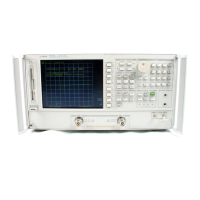34 Chapter 2
Quick Start: Learning How to Make Measurements
Learning to Make Transmission Measurements
Learning to Make Transmission Measurements
This example procedure shows you how to measure the transmission response of a
bandpass filter. The measurement parameters listed are unique to this particular test
device.
For further measurement examples, refer to the "Optimizing Measurement Results"
chapter in the HP 8753E Network Analyzer User's Guide.
Step 1. Choose the measurement parameters with your test
device connected
1. Press the Preset key to return the analyzer to a known state.
2. Connect your test device to the analyzer as shown in Figure 2-2.
CAUTION Damage may result to the device under test if it is sensitive to
analyzer's default output power level. To avoid damaging a sensitive
DUT, be sure to set the analyzer's output power to an appropriate level
before connecting the DUT to the analyzer.
Figure 2-2 Device Connections for a Transmission Measurement
3. Choose the following measurement settings:
Meas, Trans: FWD S21 (B/R)
Center, 125, M/µ (Change to match the center frequency of your device.)
Span, 125, M/µ (Change to match the bandwidth of your device.)
Menu, POWER, 5, x1, RETURN
Scale Ref, AUTO SCALE
4. Look at the device response to determine if these are the parameters that you want for
your device measurement. For example, if the trace is noisy you may want to increase
the test port output power (which increases the analyzer input power), reduce the IF
bandwidth, or add averaging. Or, to better see an area of interest, you may want to
change the test frequencies.

